Anybody know any information about the sword in this picture?
Supposedly it is in the Museum Cluny, Paris, France. I'm trying to find out more about its background; construction, who it belonged too, stats, more photos and all of that. It made it into a museum and appears to be in good shape so I'm thinking it might have a bit of a tale to tell and I'm curious whether anybody knows anything about it around here.
Last edited by Joe Fults on Mon 27 Aug, 2007 7:43 pm; edited 1 time in total
I zoomed in on the card next to the sword and I can read: Italian or German sword 15th century in French.
Smaller and almost impossible to read I can see something about what collection it's from but can't quite make it out.
Smaller and almost impossible to read I can see something about what collection it's from but can't quite make it out.
Jean,
Thanks...that's more than I knew a few minutes ago! :D
Thanks...that's more than I knew a few minutes ago! :D
BTW...I got the photo from the ARMA Bohemia website.
Not sure where they got it from.
Not sure where they got it from.
Hello,
I took this picture several years ago. It ended up on Arma Bohemia through the Company of Saynt George mailing-list. The sword is in the National Medieval museum aka "Hotel de Cluny" in Paris.
There is not much more to tell about it. I can give you the name of the collector who owned it before giving it to the museum.
It is quite an anonymous sword, nothing particular about it apart from the fact that it is very well preserved. The handle is in very good shape, very interesting especially it shows how the "rainguard" is connected to the grip. BTW, the rainguard has been most certainly cut and repaired.
The blade is a very norrow and thick type XVa blade. The cross is faceted on only one side, as it is usual for this type.
I believe it is certainly German as many sword of this type are visible on German art and in German musuem.
I took this picture several years ago. It ended up on Arma Bohemia through the Company of Saynt George mailing-list. The sword is in the National Medieval museum aka "Hotel de Cluny" in Paris.
There is not much more to tell about it. I can give you the name of the collector who owned it before giving it to the museum.
It is quite an anonymous sword, nothing particular about it apart from the fact that it is very well preserved. The handle is in very good shape, very interesting especially it shows how the "rainguard" is connected to the grip. BTW, the rainguard has been most certainly cut and repaired.
The blade is a very norrow and thick type XVa blade. The cross is faceted on only one side, as it is usual for this type.
I believe it is certainly German as many sword of this type are visible on German art and in German musuem.
| Mathieu Harlaut wrote: |
| Hello,
I took this picture several years ago. It ended up on Arma Bohemia through the Company of Saynt George mailing-list. The sword is in the National Medieval museum aka "Hotel de Cluny" in Paris. There is not much more to tell about it. I can give you the name of the collector who owned it before giving it to the museum. It is quite an anonymous sword, nothing particular about it apart from the fact that it is very well preserved. The handle is in very good shape, very interesting especially it shows how the "rainguard" is connected to the grip. BTW, the rainguard has been most certainly cut and repaired. The blade is a very norrow and thick type XVa blade. The cross is faceted on only one side, as it is usual for this type. I believe it is certainly German as many sword of this type are visible on German art and in German musuem. |
Mathieu,
Thanks so much for the reply and information.
By chance do you have any other photos of it?
Joe,
this type of sword appears in some of Albrechts Dürer's works.
The Knight, the Death and the Devil (1513)
Knight in armor (1498)
Apocalypse wood carvings (1498)
Maybe this can help you dating the blade.
Jeroen Averhals
this type of sword appears in some of Albrechts Dürer's works.
The Knight, the Death and the Devil (1513)
Knight in armor (1498)
Apocalypse wood carvings (1498)
Maybe this can help you dating the blade.
Jeroen Averhals
I have other pictures. Mostly close up of the cross and grip. I'll post them as soon as I have time.
| Mathieu Harlaut wrote: |
| I have other pictures. Mostly close up of the cross and grip. I'll post them as soon as I have time. |
Thank you!!
Here are most of the picture of the sword. Sorry, some are blurry, particularly the ones showing the full sword. The pictures were made in 2000 and the camera wasn't the best.
I hope you will find what you are looking for. If you are looking for something specific, let me know. I go to the musuem regularly and I might take other pictures if you need.
 Attachment: 48.9 KB
Attachment: 48.9 KB

 Attachment: 32.69 KB
Attachment: 32.69 KB
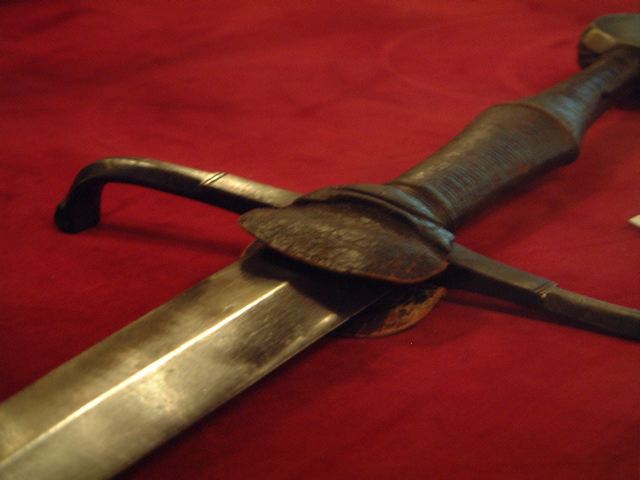
 Attachment: 38.57 KB
Attachment: 38.57 KB
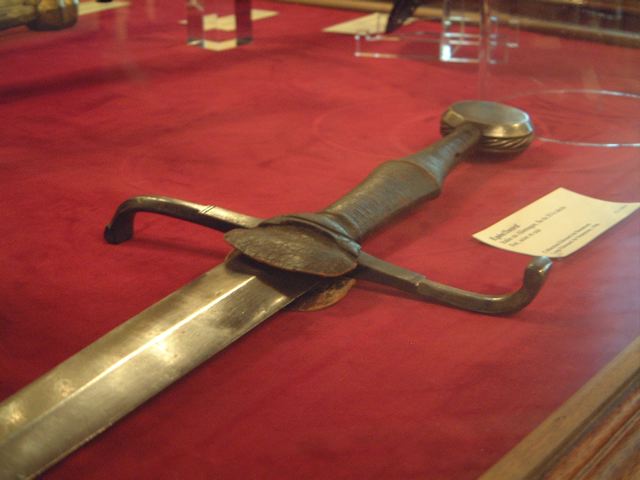
 Attachment: 37.77 KB
Attachment: 37.77 KB

 Attachment: 35.44 KB
Attachment: 35.44 KB
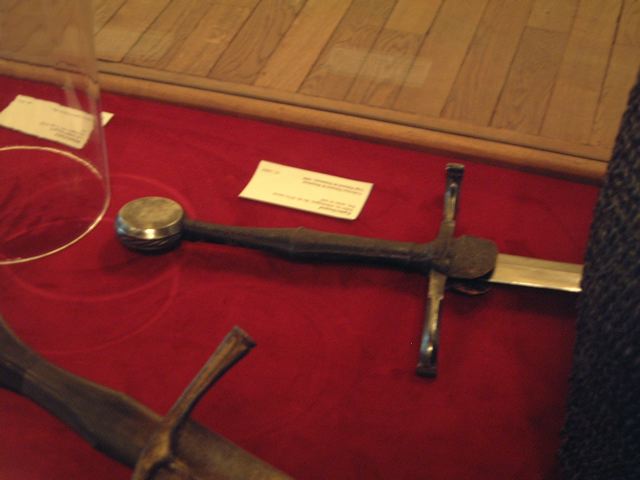
 Attachment: 29.69 KB
Attachment: 29.69 KB

 Attachment: 33.63 KB
Attachment: 33.63 KB
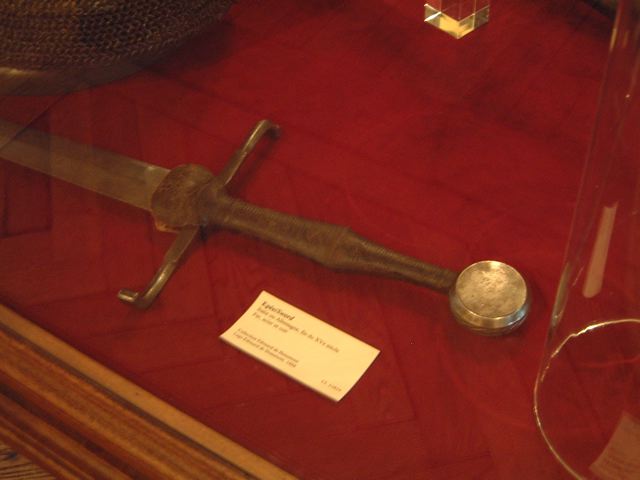
 Attachment: 33.58 KB
Attachment: 33.58 KB
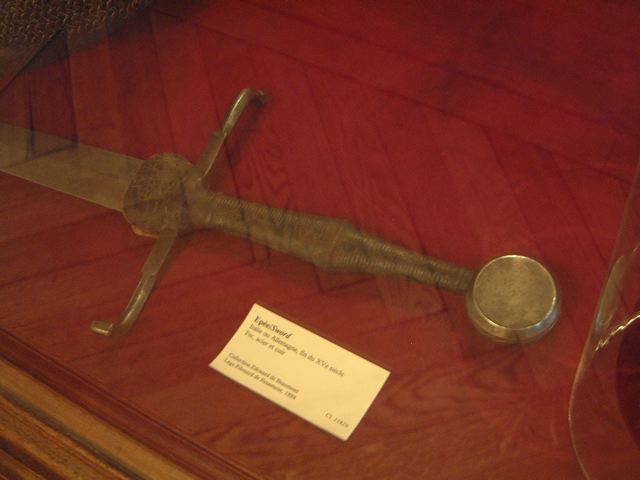
I hope you will find what you are looking for. If you are looking for something specific, let me know. I go to the musuem regularly and I might take other pictures if you need.








Some more pictures.
 Attachment: 38.51 KB
Attachment: 38.51 KB
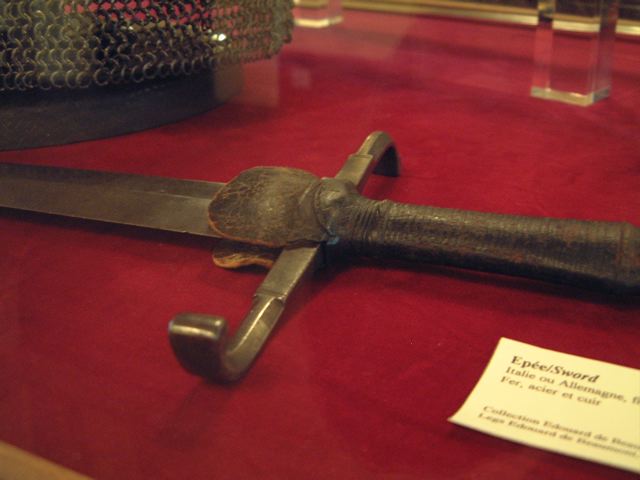
 Attachment: 31.09 KB
Attachment: 31.09 KB
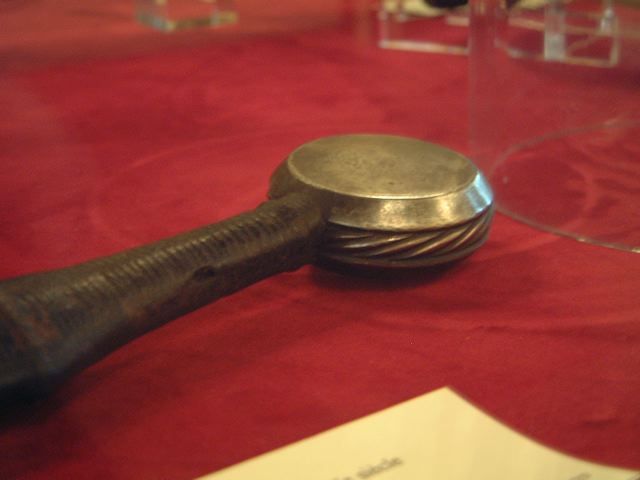
 Attachment: 33.84 KB
Attachment: 33.84 KB
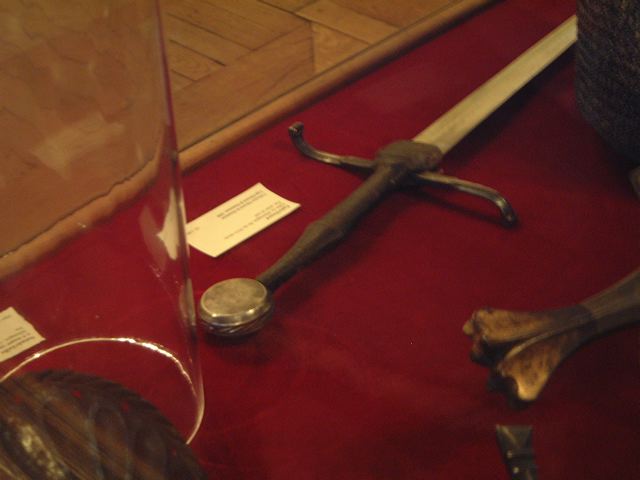



And a picture of the pommel that Peter Johnsson took as inspiration for the Albion Burgundian.
 Attachment: 101.66 KB
Attachment: 101.66 KB
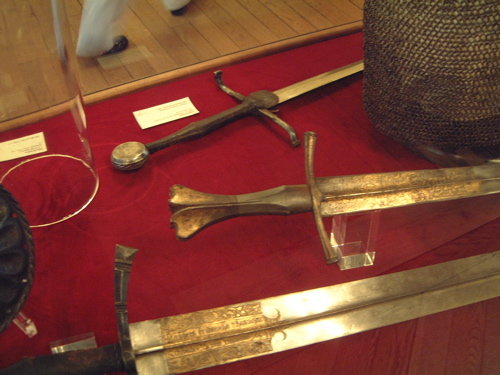

And for those you like rondel daggers. It is off-topic t since the dagger is half a meter away from the sword…
The dagger is said to be 14th century by the musuem, but when compared with period artwork it is clearly 15th century. Many burgundian piece of art show such dagger: the tapestry in Bern and above all the portrait of Charles the Bols by Van der Weyden.
 Attachment: 37.33 KB
Attachment: 37.33 KB
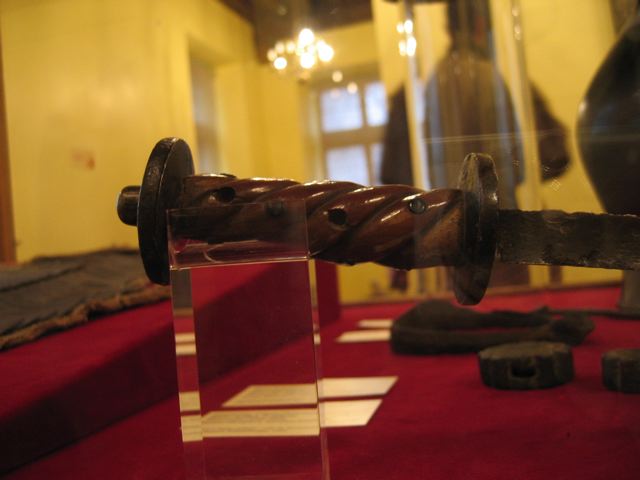
 Attachment: 50.03 KB
Attachment: 50.03 KB
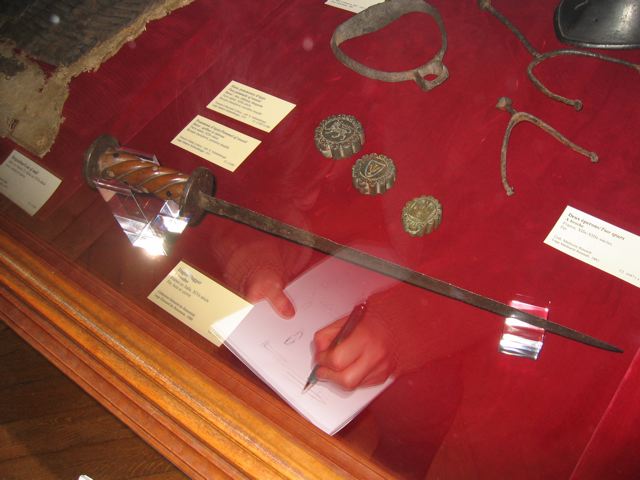
 Attachment: 36.92 KB
Attachment: 36.92 KB

 Attachment: 34.72 KB
Attachment: 34.72 KB
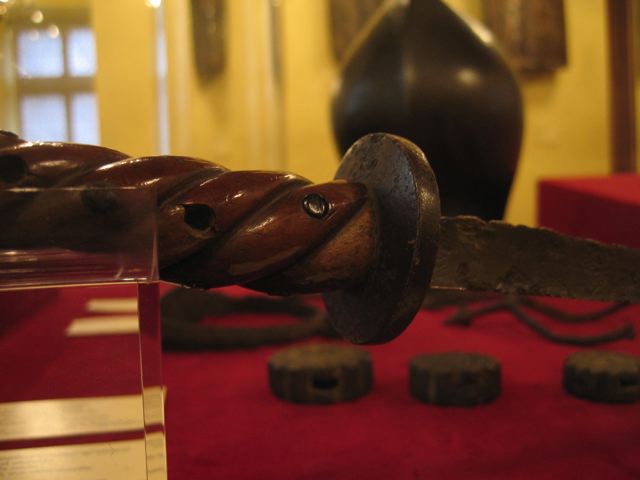
 Attachment: 33.9 KB
Attachment: 33.9 KB

The dagger is said to be 14th century by the musuem, but when compared with period artwork it is clearly 15th century. Many burgundian piece of art show such dagger: the tapestry in Bern and above all the portrait of Charles the Bols by Van der Weyden.





Mathieu,
Given that some museums won't let you take photos, getting something from any collection of originals is a treat. I really appreciate you taking the time to share these with us.
Best,
Joe
Given that some museums won't let you take photos, getting something from any collection of originals is a treat. I really appreciate you taking the time to share these with us.
Best,
Joe
..guess who had the chance to play (however liitedly) with this particular sword - and the dagger too - last Tuesday ?
:cool:
Though unfortunately, I couldn't take pics.
I wasn't really able to swing the sword around too much, as I was under close scrutiny from the curator (though I hope to make amend for that soon), but I can tell you that just from picking it up, it really is a treat ! I had too little time to study it from any closer, unfortunately. But it certainly works as fine when held one-handed than two-handed. Point response was immediate even one handed, and yet you could feel the strength and stiffness in the blade. A very fine example of an early XVIth century sword (or very late XVth).
The dagger is equally interesting. The back of the blade is flat, and its sides are hollow-ground, making it in addition of the cylindrical roundels a really light weapon, yet still feeling quite effective.
That fish-tail pommel sword (who possibly belonged to a Duke of Milan in the XVth century) was on loan to another museum, unfortunately. But I should be able to study it soon. Hopefully.
Joe : I could ask the curator for more info on the background of that sword if you'd like. Just be patient.
Cheers
Fab
:cool:
Though unfortunately, I couldn't take pics.
I wasn't really able to swing the sword around too much, as I was under close scrutiny from the curator (though I hope to make amend for that soon), but I can tell you that just from picking it up, it really is a treat ! I had too little time to study it from any closer, unfortunately. But it certainly works as fine when held one-handed than two-handed. Point response was immediate even one handed, and yet you could feel the strength and stiffness in the blade. A very fine example of an early XVIth century sword (or very late XVth).
The dagger is equally interesting. The back of the blade is flat, and its sides are hollow-ground, making it in addition of the cylindrical roundels a really light weapon, yet still feeling quite effective.
That fish-tail pommel sword (who possibly belonged to a Duke of Milan in the XVth century) was on loan to another museum, unfortunately. But I should be able to study it soon. Hopefully.
Joe : I could ask the curator for more info on the background of that sword if you'd like. Just be patient.
Cheers
Fab
Hi Fabrice,
You should have told me I would have come with you as your document carrier! :-)
Seriously the next time you come to Paris, it would be nice to meet each other.
You should have told me I would have come with you as your document carrier! :-)
Seriously the next time you come to Paris, it would be nice to meet each other.
No worries Matthieu, I'll let you know :)
Thanks for sharing the extra photos! I particularly like the roping around the edge of the pommel.
| Fabrice Cognot wrote: |
| ..guess who had the chance to play (however liitedly) with this particular sword - and the dagger too - last Tuesday ?
:cool: Though unfortunately, I couldn't take pics. I wasn't really able to swing the sword around too much, as I was under close scrutiny from the curator (though I hope to make amend for that soon), but I can tell you that just from picking it up, it really is a treat ! I had too little time to study it from any closer, unfortunately. But it certainly works as fine when held one-handed than two-handed. Point response was immediate even one handed, and yet you could feel the strength and stiffness in the blade. A very fine example of an early XVIth century sword (or very late XVth). The dagger is equally interesting. The back of the blade is flat, and its sides are hollow-ground, making it in addition of the cylindrical roundels a really light weapon, yet still feeling quite effective. That fish-tail pommel sword (who possibly belonged to a Duke of Milan in the XVth century) was on loan to another museum, unfortunately. But I should be able to study it soon. Hopefully. Joe : I could ask the curator for more info on the background of that sword if you'd like. Just be patient. Cheers Fab |
Fabrice,
That would be very nice.
If you could get any statistics...well that would be very nice too.
-Joe
For those interested in trivia, I looking at some options to get a replica of this sword created.
If Fabrice really is is able to dig up a bit more information about it sometime in the future, I think the project will be very exciting.
:D
If Fabrice really is is able to dig up a bit more information about it sometime in the future, I think the project will be very exciting.
:D
Page 1 of 2
You cannot post new topics in this forumYou cannot reply to topics in this forum
You cannot edit your posts in this forum
You cannot delete your posts in this forum
You cannot vote in polls in this forum
You cannot attach files in this forum
You can download files in this forum
All contents © Copyright 2003-2006 myArmoury.com — All rights reserved
Discussion forums powered by phpBB © The phpBB Group
Switch to the Full-featured Version of the forum
Discussion forums powered by phpBB © The phpBB Group
Switch to the Full-featured Version of the forum